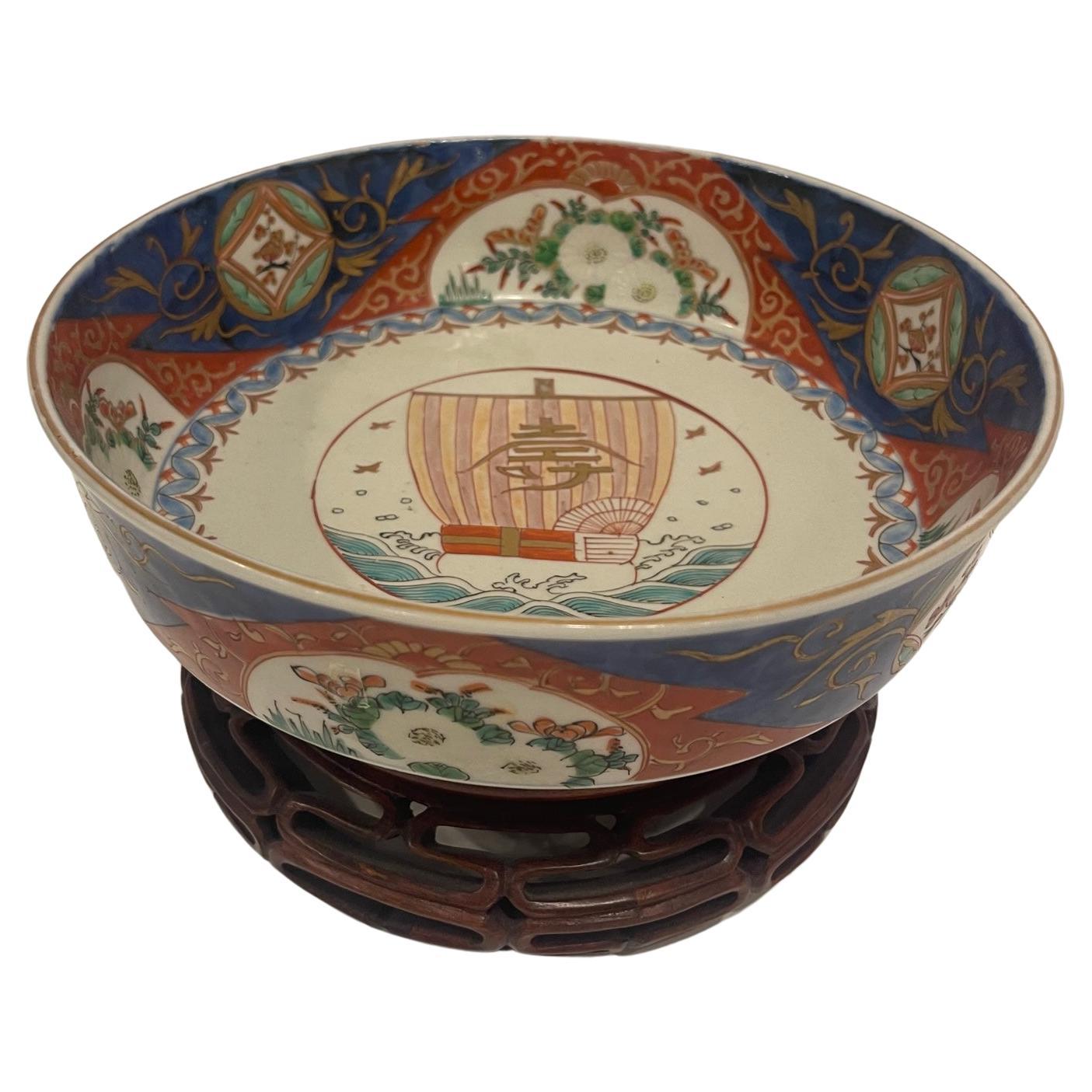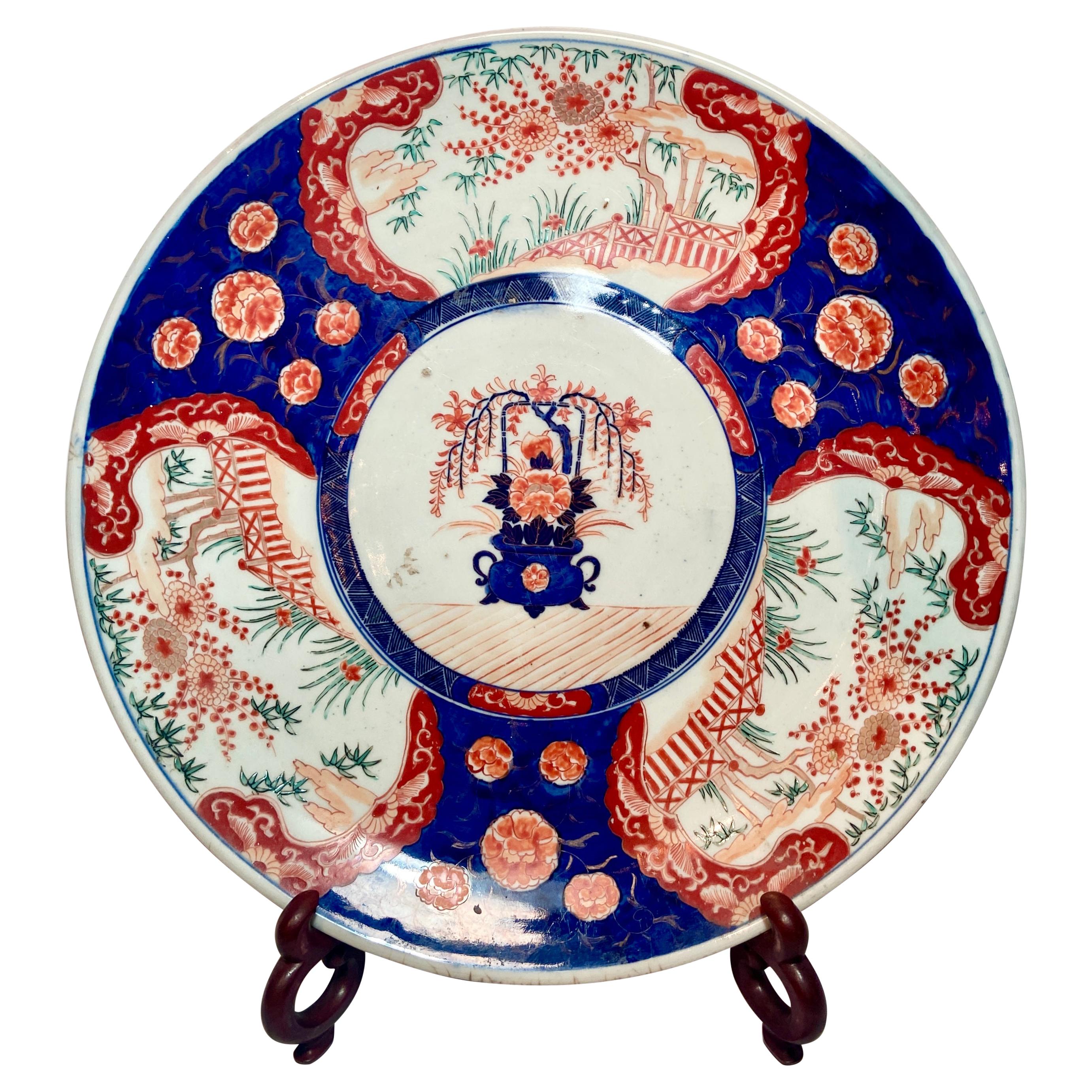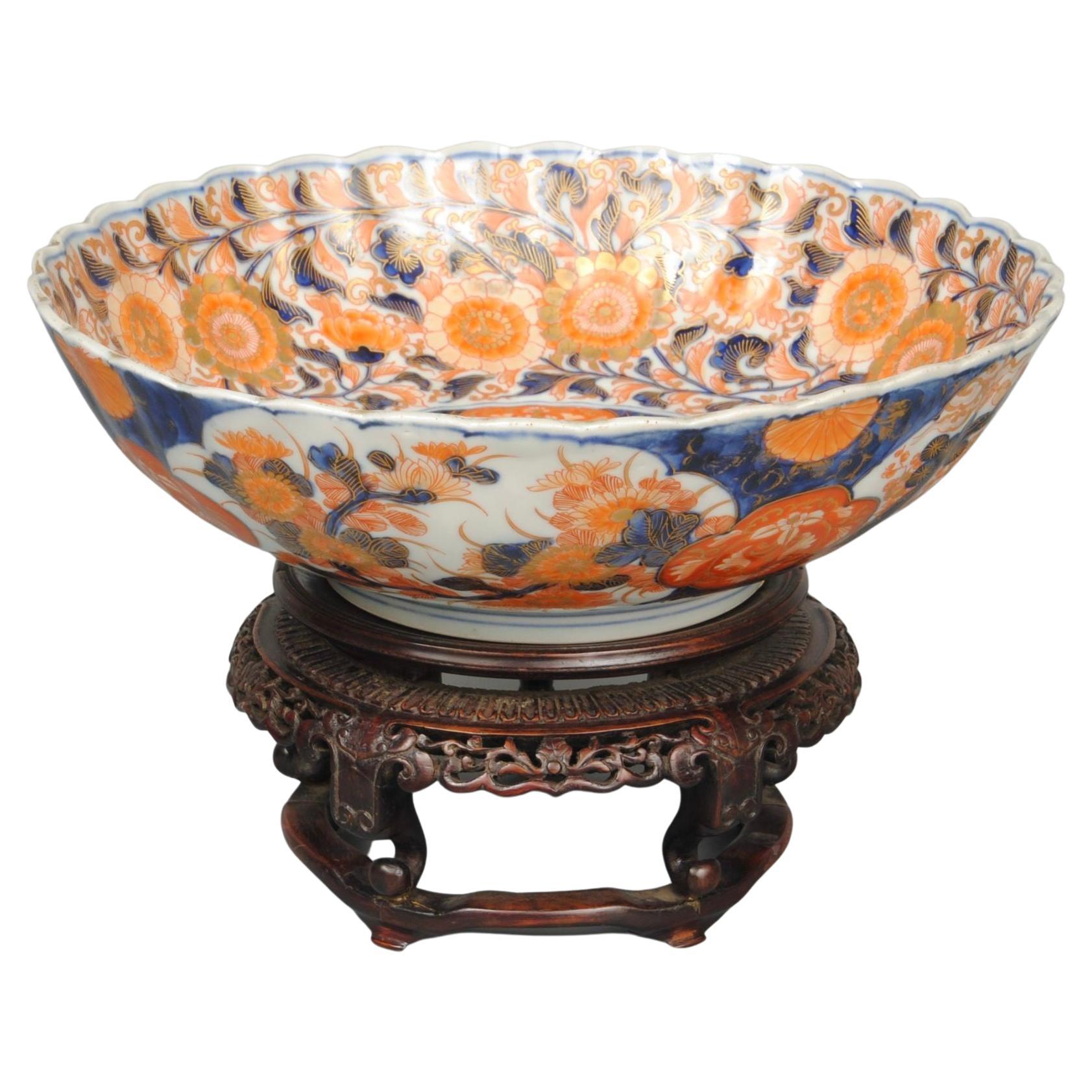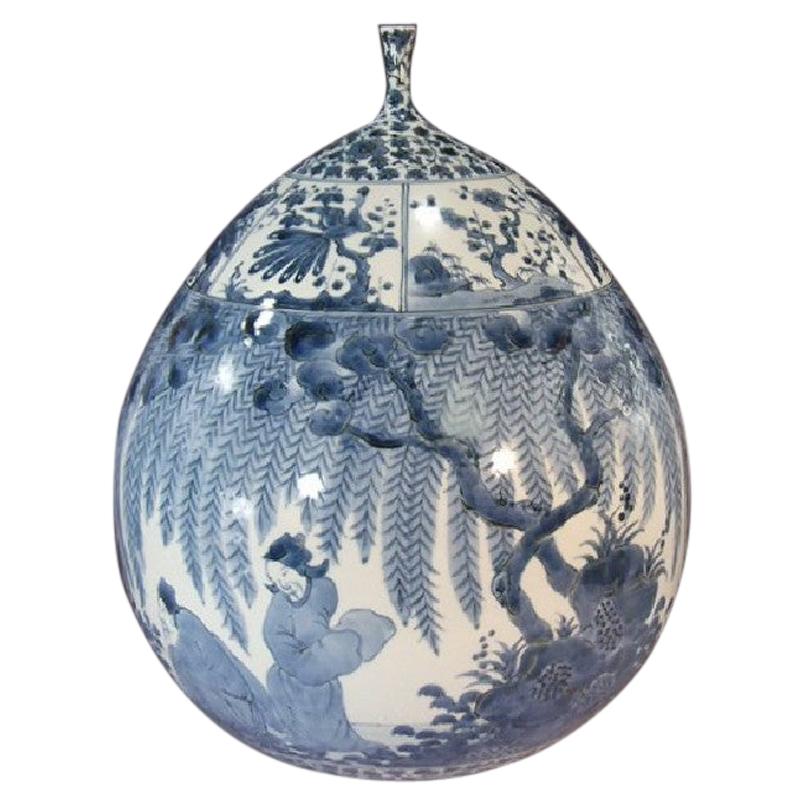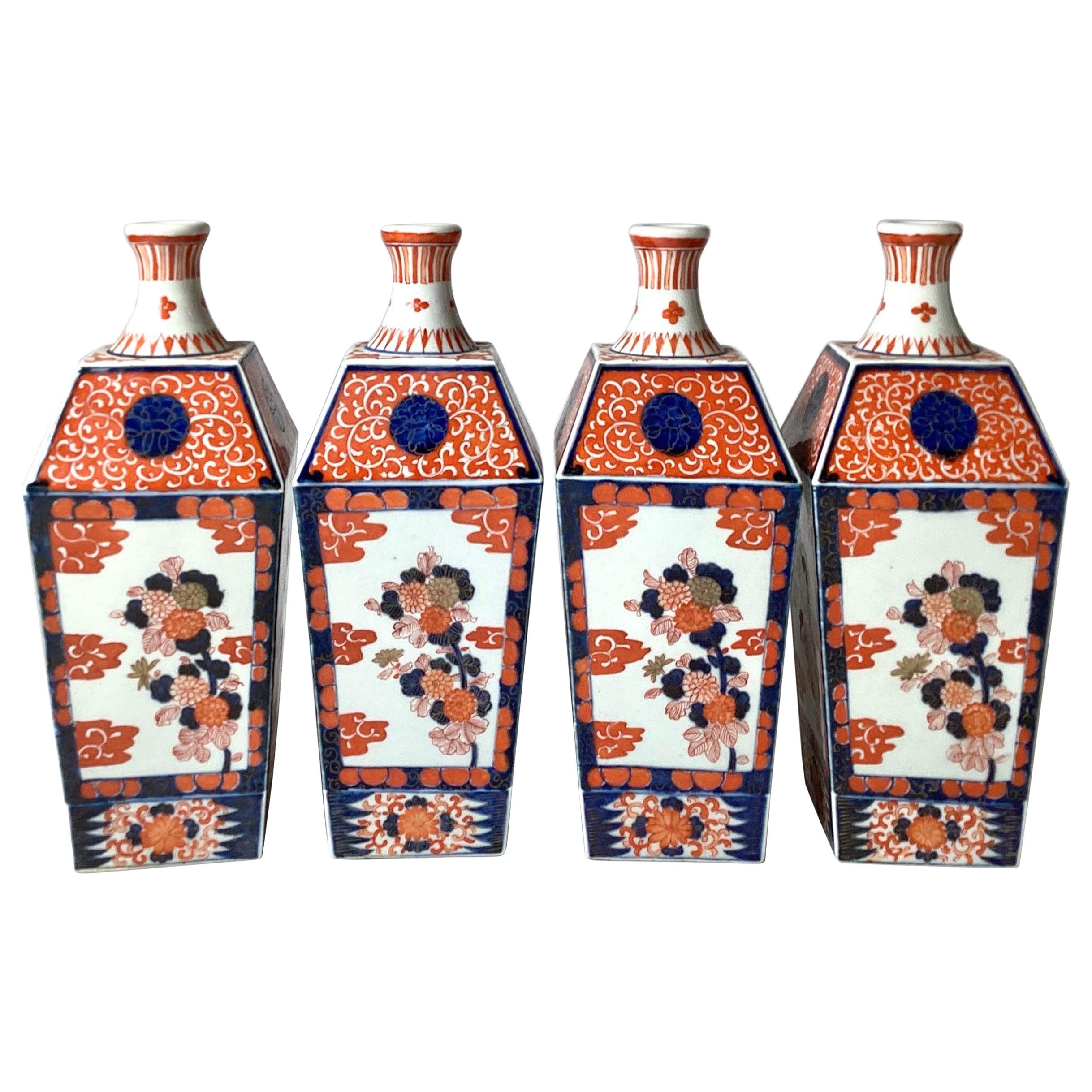Items Similar to Antique Japanese Imari Bottle Vase on Wood Stand
Want more images or videos?
Request additional images or videos from the seller
1 of 21
Antique Japanese Imari Bottle Vase on Wood Stand
About the Item
On offer is a large Japanese Imari ceramic bottle vase with elaborate surface design circa 19th century (late Meiji Period). The distinct shape of the bottle is called tea-whisk form and the rare prototype was found in the early Ko-Imari production dated back to 16-17th century of Edo period. The shape was designed specifically to store liquor. This revived bottle was made in the 19th century and showcases decoration and colors typical of Imari ware. A lady in kimono holding a fan under a Sakura tree is showcased in the front and the back, with underglaze blue contrasting the rich overglaze enamel and gold. On the two sides, raised relief borders enclose scenes of combatant dragons and tigers under plum trees, both rendered in great relief details and of sculptural quality. The base was marked in underglaze blue the archaic Chinese characters "Da Ming Cheng Hua Year Made", which was typical for some Imari ware made during that time. It was historically drilled on the base and lower flank as a lamp base. The vase comes with a carved wood stand and measures 16.25: in height overall.
- Dimensions:Height: 12.6 in (32.01 cm)Diameter: 8 in (20.32 cm)
- Style:Meiji (Of the Period)
- Materials and Techniques:Ceramic,Glazed
- Place of Origin:
- Period:
- Date of Manufacture:19th Century
- Condition:Wear consistent with age and use. Minor losses. Mellow patina and overall glaze crazing and crackling lines, spotted stains from holding the liquor. Drilled on the base and lower flank as shown.
- Seller Location:Atlanta, GA
- Reference Number:1stDibs: LU945034342042
About the Seller
5.0
Platinum Seller
These expertly vetted sellers are 1stDibs' most experienced sellers and are rated highest by our customers.
Established in 2006
1stDibs seller since 2010
479 sales on 1stDibs
Typical response time: <1 hour
- ShippingRetrieving quote...Ships From: Atlanta, GA
- Return PolicyA return for this item may be initiated within 2 days of delivery.
More From This SellerView All
- Early Japanese Satsuma Antique VaseBy SatsumaLocated in Atlanta, GAAn Satsuma ceramic stone ware vase, circa 19th century, around the end of the Edo and the beginning of Meiji period. In the form of a Classic garlic bottle whose prototype was from China, the white bodied piece is decorated with an early form of kin nishikide, the so called golden brocade, a palette of iron-red, blue, green, yellow, purple and black with golden highlight. The over glazed enamel paint shows a group of robed figures in a garden setting with a lion and three tigers. A transparent overall glaze shows very fine crackles. The design is relatively sparse with plenty of negative space in contrast to the Satsuma production from the late 19th century, when the trend became fussy and overly glitz, due to the influence by the perceived western taste for the export market. This piece may still be made for export but its pattern was more influenced by both Kyoto Pottery and the Kano school of painting compared to the export ware by the end of the 19th century onward to the early 20th century. It was believed by many that this was a result of Satsuma potters visiting Kyoto in the late seventeenth century to learn over glaze painting techniques. There are some age glaze crackles especially around the foot. The piece is not signed in keeping with the earlier production before Satsuma ceramics...Category
Antique Mid-19th Century Japanese Japonisme Ceramics
MaterialsCeramic
- Antique Korean Celadon Bottle Vase Joseon DynastyLocated in Atlanta, GAA Korean ceramic bottle-form vase circa 16th century Joseon Dynasty. It was likely intended as a wine bottle, the pear-shaped vessel with flaring neck feature a celadon glaze exterio...Category
Antique 16th Century Korean Archaistic Ceramics
MaterialsCeramic
- Large Japanese Satsuma Ceramic Vase KinkozanBy KinkozanLocated in Atlanta, GAA large Japanese ceramic vase from the end of Meiji period circa 1890-1910s by Kinkozan (1645-1927). One of the largest studio manufacturers of the export ceramics at the time based in Kyoto. In the typical style of satsuma made at the turn of 20th century, the vase is elaborately decorated with a rather unusual kinran-de (gold paint) and green enamel highlight on a mottled brown background. The painterly decoration depicts a large seasonal floral arrangement in a circular fashion. Besides the obviously superb craftsmanship, what sets this particular vase apart from many lower quality and mass-produced pieces is its tone-on-tone color pallet that is visually somber and the small and sensitive details that heralds the change of the seasons. When the viewer goes beyond the first casual glimpse of the blossom and foliage, one would notice that on the edges of certain leaves as well as along the stalks, there accumulates a very thin layer of the white dust that represents the frost. The flower in bloom are chrysanthemums. Despite of being splendid, they are the messengers of the autumn. The large lotus leaf was subtly rendered in a bended and slightly withered manner, just past its prime. Although the lotus is still in bloom, the prominent seed pod indicates it may be the last for the season. The sentimental capture of the change of the seasons is not unusual in Japanese art. This vase poetically represents such a subtle transition from summer to fall, perhaps depicting the very first frost. The neck of the vase is also slightly unusual with two rolled rings...Category
Early 20th Century Japanese Meiji Ceramics
MaterialsCeramic
- Exquisite Japanese Satsuma Vase by SeikozanLocated in Atlanta, GAA miniature vase in elegant upright form reminiscent of the Chinese imperial Willow Leaf form made by Japanese studio Seikozan circa 1890-1910s (late Meiji Period). One of the many a...Category
Antique 1880s Japanese Meiji Ceramics
MaterialsCeramic
- Japanese Satsuma Vase Yabu Meizan MeijiBy Yabu MeizanLocated in Atlanta, GAA Satsuma baluster form vase from the studio of Yabu Meizan (birth name Yabu Masashichi; 1853-1934), who is one of the most celebrated and collectible Satsuma artists from Meiji Peri...Category
Early 20th Century Japanese Meiji Ceramics
MaterialsCeramic
- Fine Japanese Ceramic Satsuma Vase by KinkozanBy KinkozanLocated in Atlanta, GAA miniature Japanese ceramic vase from the end of Meiji period circa 1880s- 1910s by Kinkozan (1645-1927). One of the largest studio manufacturers of the export ceramics at the time ...Category
Early 20th Century Japanese Meiji Ceramics
MaterialsCeramic
You May Also Like
- Japanese Imari Bowl on Wood Stand, 19th CenturyLocated in Savannah, GAJapanese Imari Bowl on Wood Stand, 19th Century. 5.5" with standCategory
Antique 19th Century Japanese Ceramics
MaterialsPorcelain
- Antique Japanese Imari Porcelain Umbrella StandBy Imari PorcelainLocated in LA CIOTAT, FRAn ideal decoration for a stylish hallway, this Japanese Imari porcelain umbrella stand dates from the end of the 19th century. Known for its colourful decorative style, Imari porcel...Category
Antique 19th Century Japanese Ceramics
MaterialsPorcelain
- Antique 19th Century Japanese "Imari" Porcelain Plate on StandLocated in New Orleans, LAStunning antique 19th century Japanese "Imari" porcelain plate on stand. 18" diameter plate. (21" high on stand).Category
Antique 19th Century Japanese Ceramics
MaterialsPorcelain
- Japanese Imari Bowl And StandLocated in Lincolnshire, GBA 19th century Japanese Imari pattern bowl on hardwood stand Circa 1885Category
Antique Late 19th Century Japanese Ceramics
MaterialsCeramic, Hardwood
- Japanese Contemporary Imari Blue White Porcelain VaseLocated in Takarazuka, JPExquisite Japanese contemporary decorative porcelain vase, hand painted in underglaze blue on a beautifully shaped body in pure white, a signed piece by widely acclaimed master porce...Category
21st Century and Contemporary Japanese Meiji Vases
MaterialsPorcelain
- Rare Set of 4 Meiji Period Imari Bottle Form VasesLocated in Lambertville, NJA rare set of four hand painted Japanese porcelain Imari bottle form vases. The vases of square tapering form with classic Imari iron red and cobalt blue ...Category
Antique 1880s Japanese Meiji Ceramics
MaterialsPorcelain
Recently Viewed
View AllMore Ways To Browse
Antique Ceramic Liquor Bottles
Chinese Dragon Kimono
Antique Japanese Blue Ceramic
Imari Ware Lamps
Antique Blue Liquor Bottles
Antique Ceramic Lady Lamp
Antique Imari Bottle
Large Meiji Tiger
17th Century Chinese Vase Lamp
Chinese Archaic Lamp
Sakura Lamp
Ming Lady
Antique Whisk
Ming Vase Lamp
Antique Holding Fan
Chinese Tiger Vase
Large Ceramic Tiger
Antique Chinese Kimono
